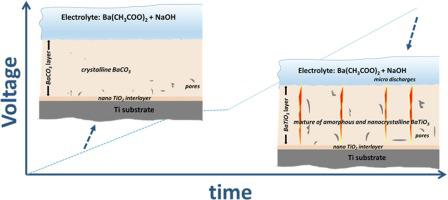当前位置:
X-MOL 学术
›
Appl. Surf. Sci.
›
论文详情
Our official English website, www.x-mol.net, welcomes your
feedback! (Note: you will need to create a separate account there.)
Microstructure of BaCO3 and BaTiO3 coatings produced on titanium by plasma electrolytic oxidation
Applied Surface Science ( IF 6.3 ) Pub Date : 2019-11-29 , DOI: 10.1016/j.apsusc.2019.144858 Hsiao-Chien Wu , Jiechao Jiang , Efstathios I. Meletis
Applied Surface Science ( IF 6.3 ) Pub Date : 2019-11-29 , DOI: 10.1016/j.apsusc.2019.144858 Hsiao-Chien Wu , Jiechao Jiang , Efstathios I. Meletis

|
BaCO and BaTiO layers were coated on titanium by plasma electrolytic oxidation at 5 mA/cm in 0.5 M Ba(CHCOO) and 2 M NaOH electrolyte. Coatings were investigated by scanning electron microscopy, X-ray and electron diffraction, and high-resolution transmission electron microscopy (HRTEM). Processing for 1 h required low voltages producing a BaCO coating along with a thin TiO interlayer (~60 nm). The coating is composed of orthorhombic BaCO nanorods that were vertically oriented at the bottom layer close to Ti substrate and horizontally oriented in the top layer close to the surface. Processing for 4 h required higher voltages resulting in generation of microarc discharges and discharge channel formation. These conditions produced a tetragonal BaTiO coating along with a broader TiO interlayer at the Ti interface composed of rutile and brookite nanostructures. It is suggested that the discharge channels promote the oxidation of the substrate along with the migration of titanium ions to the coating facilitating the BaCO to BaTiO transformation. The HRTEM evidence suggests that the latter transformation occurs via an epitaxial relationship existing between the BaTiO and BaCO crystal structures. Based on the present evidence, a structural model is proposed to describe the BaTiO growth from the BaCO lattice.
中文翻译:

等离子电解氧化钛表面 BaCO3 和 BaTiO3 涂层的微观结构
BaCO 和 BaTiO 层通过等离子电解氧化在 0.5 M Ba(CHClO) 和 2 M NaOH 电解质中以 5 mA/cm 的电流涂覆在钛上。通过扫描电子显微镜、X 射线和电子衍射以及高分辨率透射电子显微镜 (HRTEM) 对涂层进行了研究。处理 1 小时需要低电压,产生 BaCO 涂层和薄 TiO 中间层(约 60 nm)。该涂层由正交晶系 BaCO 纳米棒组成,这些纳米棒在靠近 Ti 基底的底层垂直取向,在靠近表面的顶层水平取向。处理 4 小时需要更高的电压,从而产生微弧放电并形成放电通道。这些条件产生了四方 BaTiO 涂层以及由金红石和板钛矿纳米结构组成的 Ti 界面处更宽的 TiO 夹层。这表明放电通道促进了基材的氧化,同时钛离子迁移到涂层,促进了 BaCO 向 BaTiO 的转变。 HRTEM 证据表明,后一种转变是通过 BaTiO 和 BaCO 晶体结构之间存在的外延关系发生的。基于现有证据,提出了一种结构模型来描述 BaCO 晶格中 BaTiO 的生长。
更新日期:2019-11-29
中文翻译:

等离子电解氧化钛表面 BaCO3 和 BaTiO3 涂层的微观结构
BaCO 和 BaTiO 层通过等离子电解氧化在 0.5 M Ba(CHClO) 和 2 M NaOH 电解质中以 5 mA/cm 的电流涂覆在钛上。通过扫描电子显微镜、X 射线和电子衍射以及高分辨率透射电子显微镜 (HRTEM) 对涂层进行了研究。处理 1 小时需要低电压,产生 BaCO 涂层和薄 TiO 中间层(约 60 nm)。该涂层由正交晶系 BaCO 纳米棒组成,这些纳米棒在靠近 Ti 基底的底层垂直取向,在靠近表面的顶层水平取向。处理 4 小时需要更高的电压,从而产生微弧放电并形成放电通道。这些条件产生了四方 BaTiO 涂层以及由金红石和板钛矿纳米结构组成的 Ti 界面处更宽的 TiO 夹层。这表明放电通道促进了基材的氧化,同时钛离子迁移到涂层,促进了 BaCO 向 BaTiO 的转变。 HRTEM 证据表明,后一种转变是通过 BaTiO 和 BaCO 晶体结构之间存在的外延关系发生的。基于现有证据,提出了一种结构模型来描述 BaCO 晶格中 BaTiO 的生长。


















































 京公网安备 11010802027423号
京公网安备 11010802027423号